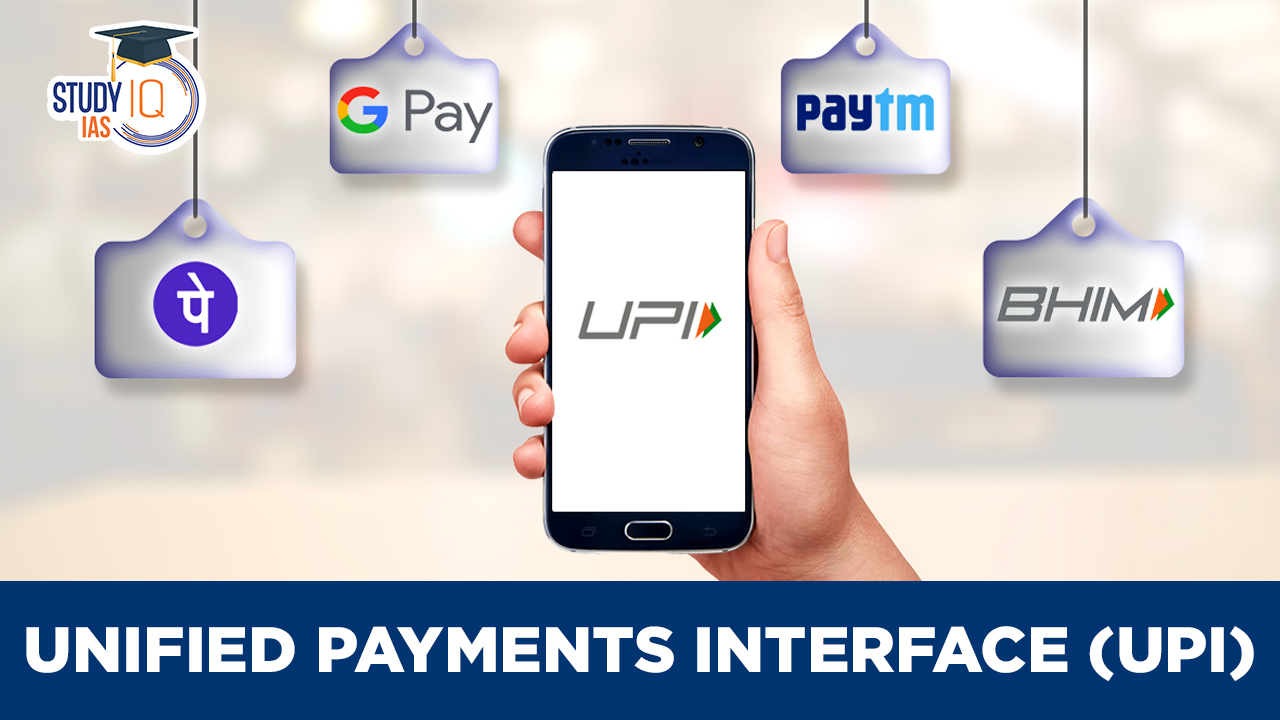Table of Contents
The RBI has decided to enhance the limit for tax payments via UPI from ₹1 lakh to ₹5 lakh per transaction. RBI is also provisioning to introduce ‘Delegated Payments’ through UPI. This will enable a secondary user, like a spouse, to make payments via UPI by using the bank account of the primary user.
- Delegated Payments would enable a UPI user to set a payment limit for another user on their bank account. This product is expected to add to the reach of digital payments.
Unified Payment Interface (UPI)
- UPI Instant payment system developed by the NPCI, It is built over the IMPS infrastructure
- The different channels for transferring funds using UPI are:
- Send/Collect through Virtual ID
- Account Number + IFSC
- Aadhaar Number
- Single mobile application for accessing different bank accounts.
- Transactions are carried out through mobile devices with two factor authentication using device binding and a UPI PIN as security.
- Unified Payment Interface (UPI) is a real-time payment system in India that enables individuals to make instant and secure money transfers between bank accounts using mobile phones. It was launched by the National Payments Corporation of India (NPCI) in April 2016, to facilitate a seamless and convenient digital payments ecosystem in the country.
| Related Concepts |
|
Also Read: UPI Charges
Achievements of Unified Payment Interface (UPI)
Unified Payment Interface (UPI) in India has achieved several notable accomplishments since its launch. Here are some key achievements of UPI:
Massive Adoption
UPI has witnessed widespread adoption across the country. It has become one of the most popular digital payment methods in India, with millions of users and a vast network of participating banks and payment service providers.
Transaction Volume
UPI has recorded remarkable transaction volumes. According to the ‘India Digital Payments Annual Report,’ UPI registered an impressive volume of over 74.05 billion transactions and a value of ₹126 trillion in 2022.
Interoperability
UPI has achieved interoperability between different banks and payment service providers. This means that users can seamlessly send and receive money between accounts held at different banks, eliminating the need for multiple payment apps or complicated processes for interbank transfers.
Read about: Commercial Banks
Pervasive Usage
UPI has extended beyond peer-to-peer transactions. It has been widely adopted for various use cases, including utility bill payments, merchant payments, online shopping, fund transfers to friends and family, ticket bookings, and much more. UPI’s versatility has made it a preferred mode of payment across multiple sectors.
Financial Inclusion
UPI has played a significant role in promoting financial inclusion in India. It has provided individuals, even those without traditional banking services, with a secure and accessible platform to transact digitally. UPI’s integration with the Aadhaar system has facilitated easy linkage of bank accounts and simplified payments for individuals.
Innovation and Ecosystem Growth
UPI has fostered a thriving ecosystem of fintech companies, startups, and businesses that have built innovative services and products around the UPI infrastructure. This has led to the emergence of new payment apps, innovative payment solutions, and enhanced customer experiences.
International Recognition
UPI has gained recognition on the global stage. Its success story has garnered attention from various countries and international organizations. The UPI model has been hailed as an example of a robust and inclusive payment system, inspiring other nations to explore similar solutions.
The achievements of UPI highlight its transformative impact on the Indian payments landscape, driving digitalization, enhancing convenience, and facilitating financial inclusion.
Read about: Types of Banks in India
UPI Challenges
While Unified Payment Interface (UPI) has witnessed tremendous growth and popularity in India, there are some challenges associated with its usage. Here are some notable challenges:
Awareness and Adoption
Despite the widespread adoption of UPI, there is still a segment of the population, particularly in rural areas, that lacks awareness and understanding of how UPI works. Educating and creating awareness about UPI’s benefits and functionality remains a challenge.
Connectivity and Infrastructure
UPI heavily relies on stable internet connectivity and robust infrastructure. In remote or underdeveloped areas with limited internet access or network coverage, users may face difficulties in accessing UPI services, leading to interruptions in transactions.
Technical Glitches
As with any digital platform, UPI is not immune to technical glitches or system failures. Instances of app crashes, transaction failures, delayed notifications, or other technical issues have been reported. While efforts are made to enhance system stability, occasional disruptions can impact user experience.
Security Concerns
While UPI transactions are secured with two-factor authentication, there is still a need for continued vigilance regarding cybersecurity. Instances of phishing attempts, fraudulent UPI apps, or unauthorized access to UPI accounts have been reported. Users must be cautious and adhere to recommended security practices to safeguard their accounts.
Transaction Limits
UPI imposes transaction limits, which can vary based on the bank and user profile. These limits may restrict higher-value transactions, impacting businesses or individuals with larger payment requirements. Although the limits are imposed to ensure security, they can pose a challenge for certain transactions.
Interoperability Issues
While UPI aims to provide interoperability across different banks, there might still be instances where compatibility issues arise between certain banks or payment service providers. This can result in transactions being declined or delayed, affecting the seamless experience UPI intends to offer.
Merchant Acceptance
Although UPI usage has increased, the acceptance of UPI as a payment method among merchants, especially smaller businesses, is still not universal. Some merchants may not have the necessary infrastructure or knowledge to accept UPI payments, limiting the options for users. Efforts are continually being made to address these challenges and enhance the UPI ecosystem.
Read about: Indian Financial System
How Unified Payment Interface Work?
UPI allows users to link their bank accounts to a unique virtual payment address (VPA) or a mobile number, making it easier to initiate transactions. It eliminates the need to enter lengthy bank account details such as account number, IFSC code, etc., during every transaction. Here is a step-by-step description to understand how UPI works.
Registration
To use UPI, you need to have a bank account with a participating bank and a mobile number linked to that account. You’ll also need to download a UPI-enabled mobile app from your bank or a third-party provider.
Linking Bank Account
Once you have the app, you’ll need to register by providing your bank account details. The app will verify your mobile number linked to the bank account using SMS verification or other methods.
Creating a Virtual Payment Address (VPA)
After registration, you can create a unique Virtual Payment Address (VPA). A VPA is similar to an email address and acts as a unique identifier for your bank account. For example, your VPA could be something like “yourname@bankname”.
Transaction Initiation
- Push Transactions: To send money to someone, you can initiate a push transaction. You enter the recipient’s VPA or choose from their contact list if they have registered with UPI. You specify the amount and provide an optional description for the transaction.
- Pull Transactions: If someone wants to request payment from you, they can initiate a pull transaction. They will need your VPA or registered mobile number to send you a payment request.
Authorization and Security
- UPI PIN: To authorize a transaction, you’ll need to set a UPI PIN for your bank account. It acts as a secure password for UPI transactions. When you initiate a transaction, you’ll be prompted to enter your UPI PIN to validate the transaction.
- Two-Factor Authentication: UPI also supports additional authentication methods such as biometric authentication or a mobile OTP (One-Time Password) for added security.
Transaction Settlement
Once the transaction is authorized, the money is debited from the sender’s bank account and credited to the recipient’s bank account in real time. UPI leverages the Immediate Payment Service (IMPS) to facilitate immediate fund transfers between participating banks.
Additional Features
UPI supports various additional features like barcode-based payments, over-the-counter payments, bill payments, subscription payments, and more. You can use the UPI app to scan QR codes or enter merchant details to make payments at physical stores or for online purchases.
By leveraging technologies like IMPS and the Aadhaar-Enabled Payment System (AEPS), UPI ensures smooth and secure transactions while providing a convenient and interoperable payment system for individuals in India. It eliminates the need for physical cards or entering bank details during every transaction, making mobile payments simpler and safer.
Read about: Public Sector Banks
Unified Payment Interface UPSC
Understanding the Unified Payment Interface (UPI) is important for UPSC (Union Public Service Commission) aspirants as it is directly related to the UPSC Syllabus, especially in the fields of economy, digital governance, and financial inclusion. Candidates must be aware of the advancements in digital payments, the role of UPI in promoting financial inclusion, and its impact on the economy. UPSC Online Coaching and UPSC Mock Test can be used by aspirants to deepen their understanding of such topics.


 Dynamic Pricing: What It Is and Why It's...
Dynamic Pricing: What It Is and Why It's...
 Index of Industrial Production 2025, For...
Index of Industrial Production 2025, For...





















